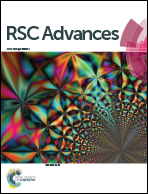High performance epoxy protective coatings incorporated with polyaniline nanowires using cardanol-based phenalkamine as the curing agent
Abstract
To investigate the performance of cardanol-based phenalkamine as curing agent, epoxy protective coatings were prepared. Different weight contents of polyaniline nanowires were also incorporated to improve the protective performance of the coatings. The wettability and the adhesion strength of the coatings were investigated. The prepared coatings were tested by immersing the samples in 12 wt% NaCl solution at 95 °C and the electrochemical impedance spectroscopy technique was used to evaluate the performance of the coatings. The experimental results indicate that the epoxy protective coatings cured by cardanol-based phenalkamine provide excellent protection for mild carbon steel. The coating containing 2 wt% polyaniline nanowires exhibits the best corrosion resistance performance and its impedance modulus at 0.01 Hz is close to 1 × 1011 Ohm cm2 after 60 days of immersion. The passive properties of polyaniline nanowires were characterized by scanning electron microscopy and X-ray photoelectron spectroscopy.


 Please wait while we load your content...
Please wait while we load your content...